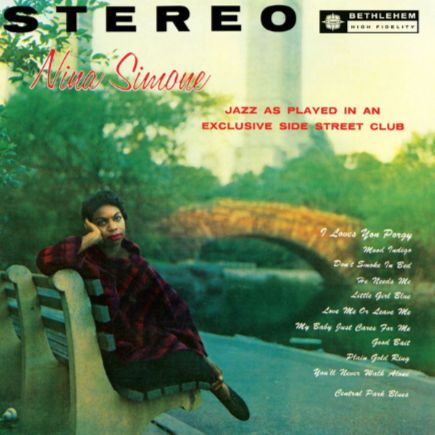Nina Simone, une voix insurgée au carrefour du classique et du jazz
Née Eunice Kathleen Waymon en 1933, Nina Simone demeure l’une des artistes les plus puissantes et les plus singulières du XXᵉ siècle. Pianiste formée dans la rigueur du répertoire classique, chanteuse à la présence magnétique, compositrice et arrangeuse, elle développe une esthétique qui transcende les frontières, reliant jazz, blues, gospel, musique populaire et héritage européen. Dès l’enfance, elle rêve de devenir la première pianiste classique noire à se produire dans les salles prestigieuses, un objectif façonné par son admiration pour Bach et son goût pour la structure, le contrepoint et la précision harmonique.
Son talent éclate lors d’un concert en 1943, où un épisode raciste – ses parents contraints de céder leurs places – marque durablement sa conscience politique. Plus tard, son refus d’admission au Curtis Institute of Music, qu’elle attribue au racisme, la conduit à jouer dans un club d’Atlantic City en 1954. Pour préserver son anonymat, elle adopte le nom de Nina Simone: ‘Nina’ pour la tendresse, ‘Simone’ en hommage à Simone Signoret. C’est là qu’elle découvre sa voix grave, à la fois chaude et autoritaire, capable de modeler chaque phrase avec une intensité dramatique rare.
En 1958, elle publie Little Girl Blue, album devenu mythique, où figurent My Baby Just Cares for Me et sa lecture poignante de I Love You Porgy, qui lui apporte une renommée immédiate. Dès ces premiers enregistrements, son répertoire témoigne d’une amplitude exceptionnelle: standards revisités, spirituals, compositions originales et chansons populaires, unies par un style expressif et profondément personnel.
Les années 1960 marquent une transformation déterminante: Nina Simone fait de sa musique une arme politique. Avec Mississippi Goddam, écrit en réaction aux violences racistes, elle signe un cri de colère et de vérité. To Be Young, Gifted and Black devient un hymne de fierté pour toute une génération, tandis que I Wish I Knew How It Would Feel to Be Free exprime l’élan universel vers la liberté. Proche des mouvements militants, elle place sa voix au service de la dignité et de la justice.
Épuisée par le climat américain, elle quitte les États-Unis après l’assassinat de Martin Luther King. Dès 1969, elle mène une vie nomade entre la Barbade, le Liberia, la Suisse, Paris, les Pays-Bas puis le sud de la France. Jusqu’à sa mort, elle reste une artiste farouchement indépendante, portée par une quête de liberté qui irrigue toute son œuvre.
Nina Simone, una voz insurgente en el cruce entre lo clásico y el jazz
Nacida Eunice Kathleen Waymon en 1933, Nina Simone sigue siendo una de las artistas más poderosas y singulares del siglo XX. Pianista formada en la rigurosidad del repertorio clásico, cantante de presencia magnética, compositora y arreglista, desarrolló una estética que trasciende las fronteras, vinculando jazz, blues, góspel, música popular y herencia europea. Desde niña soñó con convertirse en la primera pianista clásica negra en presentarse en las salas más prestigiosas, un objetivo moldeado por su admiración por Bach y su gusto por la estructura, el contrapunto y la precisión armónica.
Su talento estalló en un concierto en 1943, cuando un episodio racista —sus padres obligados a ceder sus asientos— marcó profundamente su conciencia política. Más tarde, su rechazo de admisión al Curtis Institute of Music, que atribuyó al racismo, la condujo a tocar en un club de Atlantic City en 1954. Para preservar su anonimato, adoptó el nombre de Nina Simone: “Nina” por la ternura, “Simone” en homenaje a Simone Signoret. Fue allí donde descubrió su voz grave, cálida y autoritaria, capaz de modelar cada frase con una intensidad dramática poco común.
En 1958 publicó Little Girl Blue, un álbum que se volvería mítico, donde figuran My Baby Just Cares for Me y su conmovedora versión de I Love You Porgy, que le otorgó fama inmediata. Desde estas primeras grabaciones, su repertorio revela una amplitud excepcional: estándares revisitados, spirituals, composiciones originales y canciones populares, unidas por un estilo expresivo y profundamente personal.
Los años sesenta marcaron una transformación decisiva: Nina Simone convirtió su música en un arma política. Con Mississippi Goddam, escrita en reacción a la violencia racista, firmó un grito de rabia y verdad. To Be Young, Gifted and Black se convirtió en un himno de orgullo para toda una generación, mientras I Wish I Knew How It Would Feel to Be Free expresaba el impulso universal hacia la libertad. Cercana a los movimientos militantes, puso su voz al servicio de la dignidad y la justicia.
Agotada por el clima estadounidense, abandonó Estados Unidos tras el asesinato de Martin Luther King. Desde 1969 llevó una vida nómada entre Barbados, Liberia, Suiza, París, los Países Bajos y luego el sur de Francia. Hasta su muerte, permaneció una artista ferozmente independiente, guiada por una búsqueda de libertad que impregna toda su obra.
Nina Simone, una voce insorta al crocevia tra classica e jazz
Nata Eunice Kathleen Waymon nel 1933, Nina Simone rimane una delle artiste più potenti e singolari del XX secolo. Pianista formata nella rigida tradizione del repertorio classico, cantante dalla presenza magnetica, compositrice e arrangiatrice, sviluppò un’estetica che trascende i confini, collegando jazz, blues, gospel, musica popolare ed eredità europea. Fin dall’infanzia sognò di diventare la prima pianista classica nera a esibirsi nelle sale più prestigiose, un obiettivo plasmato dalla sua ammirazione per Bach e dal gusto per la struttura, il contrappunto e la precisione armonica.
Il suo talento esplose durante un concerto nel 1943, quando un episodio razzista —i suoi genitori costretti a cedere i posti— segnò profondamente la sua coscienza politica. Più tardi, il rifiuto di ammissione al Curtis Institute of Music, che attribuì al razzismo, la portò a suonare in un club di Atlantic City nel 1954. Per preservare l’anonimato, adottò il nome Nina Simone: “Nina” per la tenerezza, “Simone” in omaggio a Simone Signoret. Fu lì che scoprì la sua voce grave, al tempo stesso calda e autorevole, capace di modellare ogni frase con una rara intensità drammatica.
Nel 1958 pubblicò Little Girl Blue, un album divenuto mitico, che include My Baby Just Cares for Me e la sua toccante interpretazione di I Love You Porgy, che le diede una fama immediata. Fin da queste prime registrazioni, il suo repertorio testimonia un’ampiezza eccezionale: standard rivisitati, spirituals, composizioni originali e canzoni popolari, uniti da uno stile espressivo e profondamente personale.
Gli anni Sessanta segnarono una trasformazione decisiva: Nina Simone fece della sua musica un’arma politica. Con Mississippi Goddam, scritta in risposta alle violenze razziste, firmò un grido di rabbia e verità. To Be Young, Gifted and Black divenne un inno di orgoglio per un’intera generazione, mentre I Wish I Knew How It Would Feel to Be Free esprimeva lo slancio universale verso la libertà. Vicina ai movimenti militanti, pose la sua voce al servizio della dignità e della giustizia.
Sfinita dal clima statunitense, lasciò gli Stati Uniti dopo l’assassinio di Martin Luther King. Dal 1969 condusse una vita nomade tra Barbados, Liberia, Svizzera, Parigi, Paesi Bassi e poi il sud della Francia. Fino alla sua morte rimase un’artista ferocemente indipendente, guidata da una ricerca di libertà che permea tutta la sua opera.
Nina Simone, an insurgent voice at the crossroads of classical music and jazz
Born Eunice Kathleen Waymon in 1933, Nina Simone remains one of the most powerful and distinctive artists of the twentieth century. A pianist trained in the rigor of the classical repertoire, a singer with magnetic presence, a composer and arranger, she developed an aesthetic that transcended boundaries, linking jazz, blues, gospel, popular music, and European heritage. From childhood, she dreamed of becoming the first Black classical pianist to perform in prestigious concert halls, a goal shaped by her admiration for Bach and her love of structure, counterpoint, and harmonic precision.
Her talent burst forth during a 1943 concert, when a racist incident —her parents being forced to give up their seats— deeply marked her political awareness. Later, her rejection from the Curtis Institute of Music, which she attributed to racism, led her to play in a club in Atlantic City in 1954. To preserve her anonymity, she adopted the name Nina Simone: “Nina” for tenderness, “Simone” in homage to Simone Signoret. It was there that she discovered her deep, warm, authoritative voice, capable of shaping each phrase with uncommon dramatic intensity.
In 1958 she released Little Girl Blue, an album that would become legendary, featuring My Baby Just Cares for Me and her poignant rendition of I Love You Porgy, which brought her immediate recognition. Already in these early recordings, her repertoire displayed exceptional breadth: revisited standards, spirituals, original compositions, and popular songs, united by a style that was expressive and profoundly personal.
The 1960s marked a decisive transformation: Nina Simone made her music a political weapon. With Mississippi Goddam, written in response to racist violence, she delivered a cry of anger and truth. To Be Young, Gifted and Black became an anthem of pride for an entire generation, while I Wish I Knew How It Would Feel to Be Free expressed the universal drive toward freedom. Close to activist movements, she put her voice in the service of dignity and justice.
Exhausted by the American climate, she left the United States after the assassination of Martin Luther King. From 1969 onward she lived a nomadic life between Barbados, Liberia, Switzerland, Paris, the Netherlands, and later the south of France. Until her death, she remained a fiercely independent artist, driven by a quest for freedom that pulses throughout her entire body of work.



